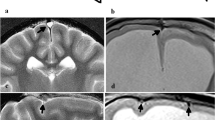Abstract
The internal jugular vein (IJV) of an adult human cadaver was used to study the effect of its behavior as a collapsible tube in regulating its upstream pressure. The results suggested that the resistance to flow in the IJV varies according to changes in its contour, which occur as a result of changes in its transmural pressure. This suggested that, in vivo, during change of posture from recumbent to erect, collapse of the IJV occurs and increases the resistance to blood flow in it. The increase in the resistance to blood flow acts as a natural self-regulating antisiphon device, which counteracts the effect of gravity and regulates the pressure above the vein, i.e., in the sigmoid sinus and, consequently, the intracranial pressure, within narrow limits, regardless of the position of the individual.
Similar content being viewed by others
Author information
Authors and Affiliations
Rights and permissions
About this article
Cite this article
El-Shafei, I.L., El-Rifaii, M.A. Ventriculojugular shunt against the direction of blood flow. Child's Nerv Syst 3, 282–284 (1987). https://doi.org/10.1007/BF00271824
Issue Date:
DOI: https://doi.org/10.1007/BF00271824




